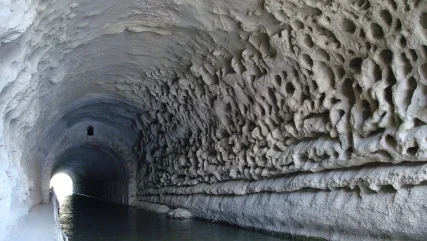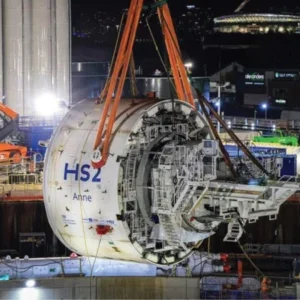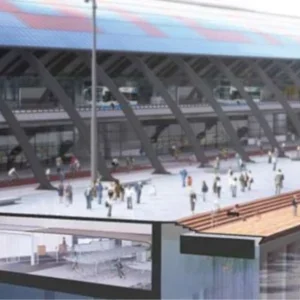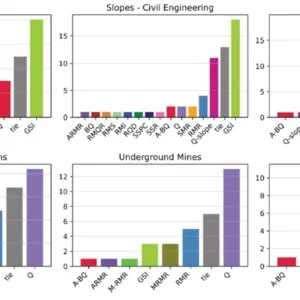
PROJECT MANAGER Ed Whitman can be forgiven some slight boasting about the contractor’s team on the new Bay tunnel crossing, declaring that "we had the right amount of planning and set ourselves up for a fast production level extremely well." The project is after all several months ahead on completion time and with a final cost of USD 288M also less expensive than its estimated USD 313M.
Whitman is half-joking and only makes these restrained comments later in an interview in response to a fair question. As well as credit for the joint venture of Michels/Jay Dee/ Coluccio, he says a good design by consultant Jacobs Engineering, and project collaboration with the client San Francisco Public Utilities Commission (SFPUC) all helped the work go well.
But he is also entitled to plaudits for a relatively dif_ cult tunnel that faced mixed soft and hard ground with potential hazardous materials like asbestos, strong environmental challenges above ground, seismic complications, and logistic constraints working from one end only of a 5-mile (8km) long bore, 15ft (4.6m) in diameter (see T&TI June 2011). Added dif_ culties included installation of a steel pipeline within the tunnel, embedded in a seismic resistant cellular concrete internal lining.
The project is a component element of a USD 4.6bn Water System Improvement Project designed in part to ensure earthquake resistance to water supplies in the San Mateo peninsula, the central part of San Francisco to the south of the Golden Gate Bridge, where there is a 2.5 million population. It repairs and replaces old pipelines across the bay originally installed for similar reasons after the devastating 1906 earthquake, upgrading the so-called Hetch Hetchy system to modern seismic standards.
The tunnel component is the first bore ever made underneath the Bay – the old pipes sit on the bed – and so the geology was a relative unknown. Test drill probes indicated mostly clay but with embedded sand lenses up to 2ft thick (0.6m) and there was an outcrop of the San Francisco complex, harder ground up to 1,400 psi in strength (10MPa), running for some 800ft (250m).
"We also had an unknown area underneath the Salt Pans," Whitman says. These are areas in the shallows of the Bay edges, divided into evaporation basins for the extraction of mineral salts of all kinds, used for industrial purposes. It is an industry present over the last century or so and one of the largest such in the world. The pans are divided by berms built on relatively soft Bay mud and the owners feared the impact of heavy drilling equipment could create instabilities. "They hold back a lot of brine," he says.
In the event the ground 120ft (36.6m) underneath proved to be a similar clay to the rest, as expected. First of the key decisions was choice of a tunnelling machine to cope with these clays, wet sands and the Franciscan complex, known to be harder but which is very heterogeneous with metamorphic components and even volcanic basalts and therefore capable of delivering surprises. The choice was an EPB TBM made by Japan’s Hitachi- Zosen, with a cutterhead designed primarily for the soft ground unexpectedly stiff, so much so it could not be broken with shovels in the starter pit excavation and tended at first to emerge from the pressure chamber screw conveyors as "one long log".
Some juggling with conditioning was needed as both polymers and bentonite made no difference.
In the end the team found a stabilised grout, being mixed for the speed with requirements of grouting at the back. As on many smaller tunnels, the six segment universal ring was grouted through the segments, using the cast in lifting holes. "Too much pressure could squeeze material along the shield into the annulus," Whitman says, "so you had to juggle that." Grout was injected into the ring as it emerged from the machine, with sodium silicate admixture to undo the stabiliser effect and set it.
Segments were from a factory in Stockton, just a 90-minute truck drive away. They were produced by subcontractor Traylor Shea who conveniently had just completed a tunnel project in Sacramento and had spare precast capacity. Steel moulds came from France. The segments used a steel fibre reinforcement which was fine, says Whitman, "though it leaves the segments slightly more prone to breakage – they are not made of glass of course, but cracks propagate in a way they don’t with a cage. We had to be careful handling them."
There were a few broken units, but not many and only one ring had to be re-done, he says. On site they were lowered into the shaft by a gantry crane, a specially fast unit custom built for the project by American Cranes "at some expense," says Whitman ruefully. From the bottom they were delivered to the machine by a rail system.
As with all the decisions on the project Michels/Jay Dee/ Coluccio had this designed with an eye to production speed, and it could carry two full rings at a time, with the TBM backup train able unload and store them.
"That way the machine would not find itself waiting for rings," Whitman says, "even at the end of the drive when the single track haul train was making a full 8km trip and back to the starter shaft."
The train used electric locomotives, also Japanese, which Whitman says proved just right, the batteries lasting long enough to last through an entire 10-hour shift before recharging was needed. Spoil removal meanwhile was done with a conveyor, leaving the tracks clear for deliveries. Inside the tunnel this was a Goodyear system, brought in from a previous location. It ran up the side of the shaft side to a motor at the top. But the spoil was tripped off the belt at the shaft base to be picked up be a vertical belt. This was carefully thought out too. "We looked at various systems including a sloped cutting or tunnel out of the shaft but decided to use a vertical conveyor. But the usual bucket type could have been a problem, because of the sticky nature of the spoil."
The team used a relatively new "box" design from Japanese maker Hirosawa, which has "accordion style" pleated sides that can grip the spoil for the lift and then more easily discharge it at the top. From there it ran another 500ft (130m) to a spoil injection behind the segments, worked quite well. It was a cement, water, bentonite mixture with stabilising additives which kept the mix "live" for almost a month. The next problem however was tackling the sand lenses. Unlike the impermeable and dry clay the spoil was full of water and tended to emerge as a "slop".
Whitman says, "The difficulty was to change the conditioning in time because the operator would hit a lens and fill the chamber before he knew it." "The sand ‘slop’ disrupted the balancing air bubble in the chamber and then if it built up to the extraction screw air would travel at some velocity and splatter everything," he adds.
The problem was partly due to the choice of twin extraction screws which were designed with an open spiral rather than one around a spine shaft. The shape gives a higher capacity, which the contractor wanted for speed of operation but has less friction to resist such surges. The trick was judicious use of calliper gates mounted between the two screws which are set one behind the other, and a guillotine gate at the end.
Further spoil problems were faced in the harder ground which tended to come out in long slivers that could jam the open screw configuration. Slowing the drive rate helped deal with that. Another challenge was to balance the forward pressure of the machine for handling pit again on a Goodyear line, with mobile placer conveyors to distribute it around a large "bean-shaped" pit. "We used a big area because the final disposal sites were at the edge of the bay on marshy ground, and they could have problems in bad weather," he says, having to shut for perhaps some days so there had to be room to stockpile.
The tips are part of a major environmental reclamation around the Bay, which is restoring some of the old salt pan areas to the condition thought to represent the original natural state. It will all make up part of the Don Edwards wildlife refuge, first of its kind in California. Just under 300 species of birds are likely to use it. The big spoil area came in useful for the harder ground spoil. It had been anticipated that this could be contaminated with natural asbestos, requiring segregation, and disposal to special sites. In the event there was less than expected.
"But instead we found naturally occurring heavy metals like chromium, cobalt, an caesium," Whitman says, "and we had to treat the spoil separately for that reason." It took 24 hours to test each batch from a 100ft (35m) of drive to see if it was safe or not. While the tunnelling was underway the contractor was also figuring out the end point shaft excavation. The start shaft, made back in 2010 when the work began, had been difficult enough. It used diaphragm (slurry) walls and excavation inside under water to the 120ft (36m) tunnel depth, and required divers to complete.
"At that depth they can only work for 40 minutes before going through decompression, and then waiting for a 24-hour period for the next job," Whitman says.
The 27ft (8.3m) wide end shaft had constraints on its location. On one side it was close to the environmentally protected area and the designer, fearful of potential spillages, wanted to keep it as far away as possible. But the other side was close to the old pipeline, running on trestles and in a sensitive condition. The contractor felt a redesign was possible, allowing a reduction in size to 20ft (6.1m), sufficient to take out the core part of the TBM if the shield was made sacrificial and left in the ground. That gave a bit of space but even so the heavy loads of diaphragm wall rigs were thought too much, as would be a caisson.
"We opted for ground freezing instead using a brine system," Whitman says. The hardened ground was carved out with a roadheader in 5ft increments lined with ribs and lagging before a permanent concrete wall.
The shaft was then used to remove the main parts of the TBM, which finished its drive in January 2014, six months ahead of schedule, having averaged 34ft (10.5m) a day and peaking at 220ft (67.7m). From both ends, the tunnel had to be cleared not just of the long TBM train but also of rails, conveyor and so forth, to make way for the second phase of the job, installation of the pipeline. The water line is an embedded pipe sealed within a concrete jacket that protects against expected seismic shock in this most vulnerable of areas. It also gives corrosion protection, particularly by using a PFA rich mixture for the concrete design, explains Jacobs Engineering construction manager Robert Mues. The alignment deliberately does not cross the two major faults along the Bay but is close to them and future shocks. Installing the pipeline has also been complex. First the 9ft (2.8m) diameter pipe has to be assembled within the tunnel from the 40ft-long spiral welded sections delivered. It then has to be welded into a single string, and finally embedded by filling the 18in (460mm) annulus with concrete. This can be difficult enough above ground where at least the joining operation can be done from the outside, obviously not possible in a tunnel. "The challenge is that pipes that length behave like wet Chinese noodles," Whitman says. To keep each length stiff and properly positioned for welding a special "pipe placer" unit is used, "like a long travelling beam a bit bigger than a pipe length."
These are used commonly though the JV had its own tailor made version built, and in fact modified after a few initial runs highlighted some flaws in its operation. The unit has to travel through the pipe, and then pick up the next delivered string from the tunnel floor and hold it in position for welding. This is not easy as high precision is required firstly and secondly, the roundness of the pipe has to be exact.
"The pipes tend to go out of shape and so there is a pipe rounder, looking rather like a TBM gripper but all around the inside of the pipe." Whitman says. "This holds the pipe shape against a backer plate slid over the joint against which the welders can then join the two sections."
But this work is fraught too. "You can easily get a ‘wave’ in the pipe steel, running ahead of the weld which causes problems as you finish," he explains. The possible distortion can also arise from temperature differences expanding the steel as it is welded. "So first you have to stitch the weld to hold it."
Once all this is done the pipe have to be carefully positioned inside the tunnel, supported on stools at intervals with screw jack adjusters to make sure it is centrally placed. Stiffeners inside the pipe are positioned exactly against the outside stools to prevent loads buckling the pipe.
"Then you backfill the entire length in one go," Mues says, "which is also problematical because of buoyancy effects as the grout travels along the annulus."
A series of grout fillings lifts were used to minimise the effects and the pipe was finally completed in the autumn last year.






